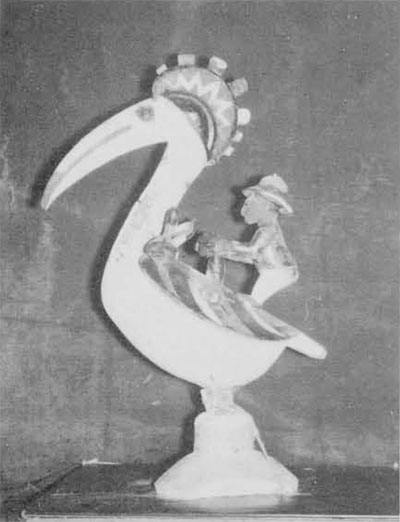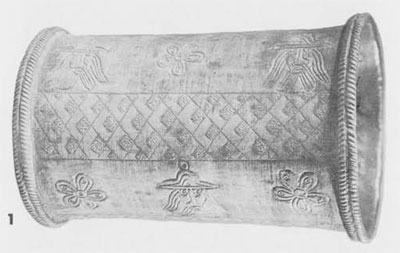

Museum Object Number: AF3667
Europeans occur in the tribal art of Nigeria as far back as the 17th century when Portuguese sailors navigated the waters of the Niger River and established lively trade with the despotic kingdom of Benin. These bearded gentlemen found their images used decoratively on a variety of artifacts–girdle masks, boxes, and even jewelry. The examples that have come down to us from this period are cast in bronze. In some cases, as in a wide bronze armlet (1) in the Museum’s collection, the bronze was carefully embedded with another metal–copper–to embellish the piece and isolate a decorative motif. Portuguese heads, hatted and bearded, in the fashionable long hair of the period alternate with rosettes in every other longitudinal band of the armlet.
Is the almost cartoon style intentional? Benin craftsmen, first-class metal casters and designers, we assume, found these beards, this straight hair, that cavalier hat, bizarre and worthy of caricature short of understanding. Humor often plays a part in the European-influenced wood carvings that have been produced in Nigeria in the past six decades. Trained, sensitive, and sophisticated carvers exist in the villages of Yorubaland to this day. These artists, many unfortunately anonymous, could easily look at the visitors to their villages and capture in the timeless monumentality of uninhibited tribal art the figure they cut.
Leon Underwood, the sculptor, writer, and ethnographer, visited a village near Lagos. “The chief thought I was a mystery-man. He gave ma a small orchestra to lead my way, guiding me and preceding me wherever I went in this area. They wanted me to stay on there.”
Impressions of white men are often strong in the life of these tribal outposts. The soldier is certainly an ever-present type. One particularly poignant representation of a fin-de-siecle warrior (2) in the Museum’s collection boasts gun and complete uniform except shoes. The figure placidly stands at attention and retains still the typical heavy-lidded Yoruba eyes.
Another category of strangers is the trader. The usual trader to these parts is the Arab. Two wonderful examples are to be seen on a “giftwrap” wooden box carved and painted (3), probably made to hold nuts. These exotic salesmen support, caryatid-fashion, the shallow carrier. The beard plays a major part and the eyes, carefully articulated, combine with the flowing Arab dress to complete the characterization.
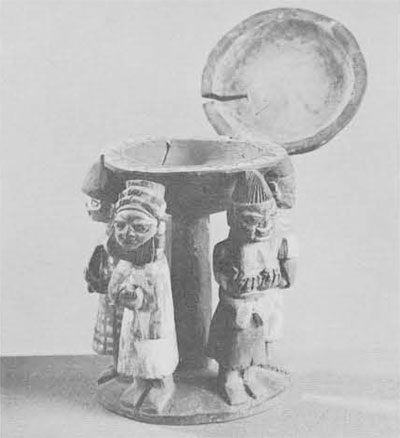
Museum Object Number: AF3671
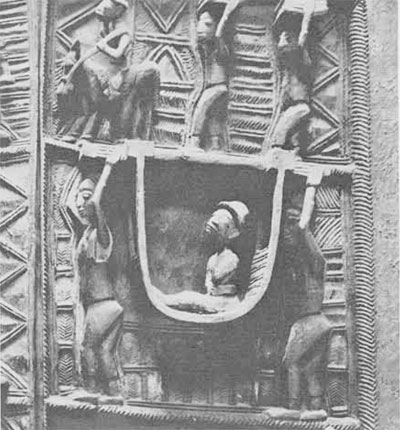
The explorer often appears on the scene. There is a wonderful portrait in one of those pictorial panel doors (4) carved by Areogon of Abeokuta in Yorubaland, one of the treasures of the British Museum. Carried in a litter, the European relaxes as he surveys the scene. Another piece (5), from The Olsen Foundation, shows the white subject astride his seat, his booted feat hanging in abject resignation, his now fully Europeanized eyes staring straight ahead, his lips parted, ready for whatever may come. The pith helmet and immaculate uniform complete the subtle caricature.
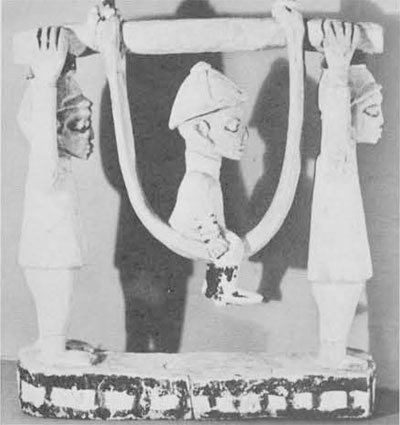
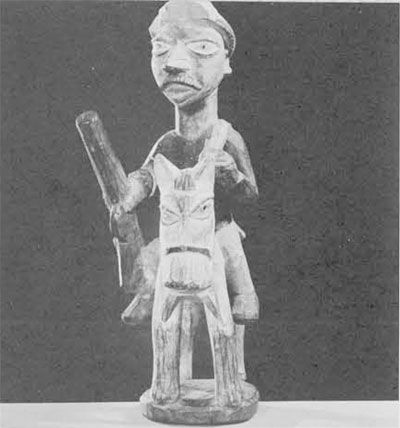
The hunter, mounted, gun poised, has been monumentalized in still another Yoruba wood carving (6) in The American Museum of Natural History in New York City. The rider, astride a wise and patient animal, proceeds with vigor and purpose in a most realistic presentation of the European.
The preacher-missionary is around the villager long enough to be very well known. A figure in the Museum (7) portrays the Man of God, stolidly patient, holding open a Bible in an attitude of preaching. Charm and candor appear in the treatment of the conservative hat and the emphasis of the intense eyes by a circle of small dots painted around them.
Variations of clothing don’t escape the Yoruba carver’s eyes. A dance mask (8) of recent manufacture, from the United States National Museum of the Smithsonian Institution, is crowned with four figures. Two of them are native ladies, two white men wearing shorts. They have been endowed with tribal markings carefully painted on.
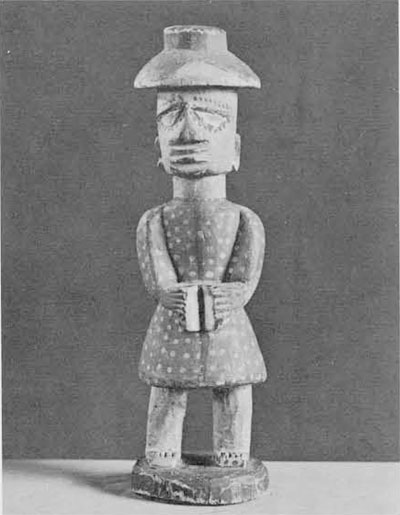
Museum Object Number: AF3668
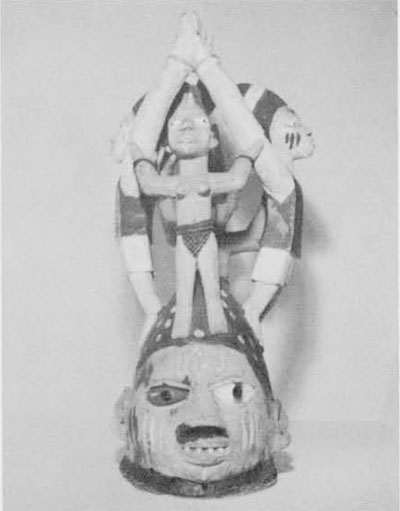
Perhaps a rare glimpse of a stranger engaged in his occupation is to be seen on a wooden painted headdress ornament (9) from the Musee de la France d’Outre-Mer in Paris. Carved by a Baga craftsman in the French Sudan, the scene is set on the back of a crested hornbill. An avid collector is busy gathering a Nimba headdress mask. This carving, executed about 1930, is a magnificent document of cultural contact and an apt artifact made to be shown at an Exposition of the colonial interests of France.
Even the great received vivid characterization as in a crowned and labeled half figure of Queen Victoria (10) in the collection of Dr. William Bascom. In deference to the climate, for certainly the artist thought of her as being in Yorubaland, Her Majesty has been thoughtfully provided with a fan.
Color plays a major role in the decoration of these carvings. The clothing is often vividly colored or immaculately white. the eyes in some cases are blue. Representation of European skin, however, is the most telling feature. For, as others see, the pigment is pink.
